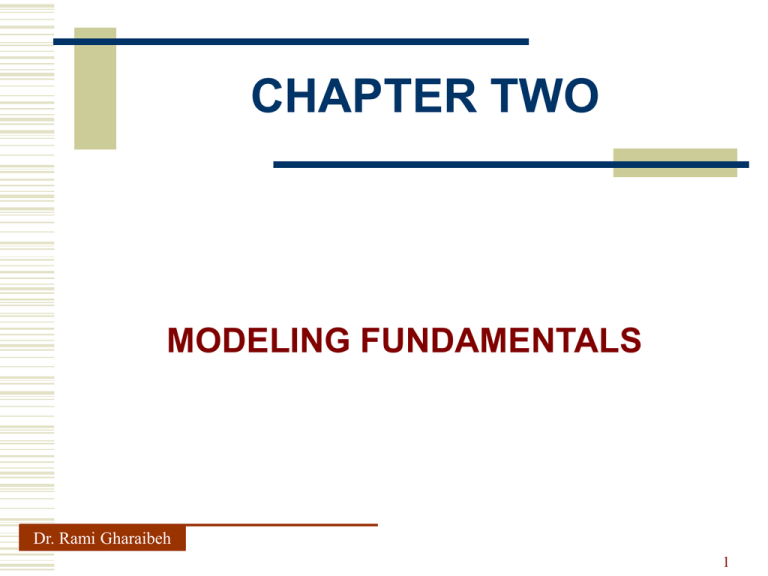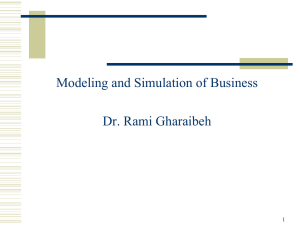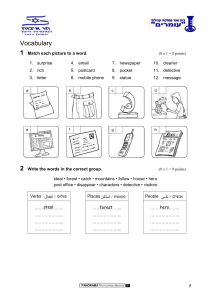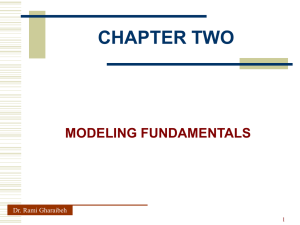CHAPTER TWO MODELING FUNDAMENTALS Dr. Rami Gharaibeh 1
advertisement

CHAPTER TWO MODELING FUNDAMENTALS Dr. Rami Gharaibeh 1 CHAPTER TWO Model Fundamentals Every model we have ever created is wrong, as is every model you will ever build. Dr. Rami Gharaibeh 2 CHAPTER TWO Model Fundamentals Being wrong is part of the nature of a model. The world that we model is much richer, much more complex, and much stranger than the models that we build of it. Dr. Rami Gharaibeh 3 CHAPTER TWO Model Fundamentals statistician George Box said it best: “All models are wrong. Some models are useful.” Sometimes people discuss whether a model is right or wrong, but that discussion is pointless since all models are wrong. Instead people should discuss whether the model is useful. Dr. Rami Gharaibeh 4 CHAPTER TWO Model Fidelity The fidelity of a model is a measure of how closely the model approximates the real world. Fidelity is an inverse measure of wrongness: a high-fidelity model is less wrong than a low-fidelity model. Dr. Rami Gharaibeh 5 CHAPTER TWO Model Fidelity Fidelity is all about shades of gray. A model can be a sort of accurate reflection of reality (for its purpose), and another higher-fidelity model can be more accurate. Dr. Rami Gharaibeh 6 CHAPTER TWO Model Validity A model is valid if it meets all the constraints, and it is invalid otherwise. Validity is a property of the model itself. Does the model meet the constraints? Then it is a valid model. All models have these two qualities: validity and fidelity. Dr. Rami Gharaibeh 7 CHAPTER TWO Classical business models organizational chart The org chart focuses on the employees and the reporting relationships. Dr. Rami Gharaibeh 8 CHAPTER TWO Organizational chart Dr. Rami Gharaibeh 9 CHAPTER TWO Classical business models Balance sheet The financial statements focus on how much money the restaurants are earning and what financial assets and liabilities they have. The two business models serve different purposes, and they are complementary. Dr. Rami Gharaibeh 10 CHAPTER TWO Balance sheet Dr. Rami Gharaibeh 11 CHAPTER TWO Four new model disciplines Recently four newer business models have become important, models that complement the classic models. Instead the four new models focus on some different parts of the complex reality of business. These new models open up some new views of business —new views for new purposes. Dr. Rami Gharaibeh 12 CHAPTER TWO Four new model disciplines The four new models are business motivation models, business organization models, business process models, and business rule models. Each of these four kinds of models is a model discipline. Dr. Rami Gharaibeh 13 CHAPTER TWO Four new model disciplines A model discipline includes a set of constraints for determining whether a model is valid. The constraints are different from one model discipline to another. Dr. Rami Gharaibeh 14 CHAPTER TWO Four new model disciplines Each model discipline has a different focus, different questions that it can answer, and different analyses that it supports. When modeling a business, you usually build models in several different model disciplines, to look at the business from different angles. Dr. Rami Gharaibeh 15 CHAPTER TWO Four new model disciplines The four model disciplines also complement the classic accounting and organizational disciplines. If you wait long enough, everything important eventually shows up in the accounting, but sometimes not until it is too late to fix. Dr. Rami Gharaibeh 16 CHAPTER TWO Four new model disciplines example a restaurant can have good books this year but be slow to seat and serve guests. This will lead to customer dissatisfaction and lower demand. Accounting will show this next year, as the revenues decline. A business process model of how people are seated and served will illuminate the problem today. Dr. Rami Gharaibeh 17 CHAPTER TWO Four new model disciplines example a restaurant can have good books this year but be slow to seat and serve guests. This will lead to customer dissatisfaction and lower demand. Accounting will show this next year, as the revenues decline. A business process model of how people are seated and served will illuminate the problem today. Feedbackward controlling vs. feedforward controlling Dr. Rami Gharaibeh 18 CHAPTER TWO model discipline maturity Accounting is mature, with a long history and hundreds of thousands of professional practitioners around the world, accountants who focus their efforts on creating and interpreting accounting models. Dr. Rami Gharaibeh 19 CHAPTER TWO model discipline maturity Business process modeling is not mature enough yet. Until then, we must content ourselves with degrees of fidelity, without any professional consensus about how much fidelity is enough. Until consensus is achieved we must rely on our own judgments. Dr. Rami Gharaibeh 20 CHAPTER TWO model usefullness To be useful, a model must have enough fidelity for the intended purpose. But fidelity alone is not sufficient. Models are read and interpreted by people, sometimes by the same people who built the model, and usually by others as well. An overly large model is not useful; it cannot be comprehended, and so the purpose of the model will not be achieved. Dr. Rami Gharaibeh 21 CHAPTER TWO model usefullness The following diagram shows strategy alternatives for Adelina restaurant and the consequences of the different alternatives. There are 14 model elements in and 18 associations among these model elements. If a model is too big and complex to be understood, it will be ignored. Dr. Rami Gharaibeh 22 CHAPTER TWO model usefullness Dr. Rami Gharaibeh 23 CHAPTER TWO model usefullness Beginning modelers often build models that are too big and too complex; they often ignore the limits of human comprehension. Dr. Rami Gharaibeh 24 CHAPTER TWO model usefullness How big is too big? A useful rule of thumb is that a model should have no more than nine elements. Nine is about how many things a typical person can keep in her head on a good day. Beyond nine, people often get confused. And if the model you built confuses the people who read it, the fault is yours, not theirs. Your model is not easy to understand. Dr. Rami Gharaibeh 25 CHAPTER TWO model attractiveness Attractive models are easier to understand and more readily accepted than ugly models. Attractive models are therefore more useful. Dr. Rami Gharaibeh 26 CHAPTER TWO model attractiveness The following example shows the activities performed by a server, a bartender, and a cook in taking drink and dinner orders in a restaurant, preparing them, and serving them. This is a valid business process model, and it is simple enough, but it is ugly. Dr. Rami Gharaibeh 27 CHAPTER TWO model attractiveness Dr. Rami Gharaibeh 28 CHAPTER TWO model attractiveness the following example shows the same business process model after a makeover; it has the same modeling elements and flows, but they are arranged in a manner that is visually appealing. Dr. Rami Gharaibeh 29 CHAPTER TWO model attractiveness Dr. Rami Gharaibeh 30 CHAPTER TWO model attractiveness The unconscious emotional response to an attractive model has another effect: It makes the model more persuasive. As described in Chapter 1, models are not just used for communication. They are also used for persuasion. Dr. Rami Gharaibeh 31 CHAPTER TWO Modeling tools Some models use special-purpose modeling tools that exist just for creating business models. Other modelers use general-purpose diagram drawing tools (such as Microsoft Visio™) that are used both for creating business models and for many other diagramming uses. Both provide functionality to make models attractive: fonts, colors, and model element layout. Dr. Rami Gharaibeh 32 CHAPTER TWO Modeling tools Visio offers no special support for recording the typical duration of an activity or for noting the sub-process behind an activity. Visio understands the activity as a rectangle in a drawing, not as an activity in a business process. The special-purpose modeling tools are better for business modeling. These tools understand business activities as activities, not as rectangles. Dr. Rami Gharaibeh 33 CHAPTER TWO Modeling tools Special-purpose modeling tools also make it easier to build valid models. Many tools support business process simulation, allowing you to experiment with prospective business processes to see what happens. Some tools support direct execution in a business process engine, allowing you to turn your business process model into executable workflow. Dr. Rami Gharaibeh 34 CHAPTER TWO Application interface and publication Business modelers work with a modeling tool to create models and analyze the models they create. But every model built by a modeler will be consumed by others. These consumers of business models do not have any modeling tools loaded on their desktops. To make models accessible to this wider audience, many of the business modeling tools have publication functionality. A model can be published to a variety of accessible formats: HTML, PDF, Microsoft Word Dr. Rami Gharaibeh 35 CHAPTER TWO Simulation Sometimes it is difficult to understand the implications of a business model, particularly complex business models and models that have many interacting elements. Simulation is a technique for running a model to get a deeper understanding. Many business modeling tools support simulation. A model that simulates is more useful than one that does not. Dr. Rami Gharaibeh 36 CHAPTER TWO Simulation what is simulation, really? First, simulations are based on models. Within SimCity is a model of a city: houses, neighborhoods, roads, rail, parks, and malls and the Dr. Rami Gharaibeh 37 CHAPTER TWO Simulation First, simulations are based on models. Within SimCity is a model of a city: houses, neighborhoods, roads, rail, parks, and malls and the interactions of people who live in those houses, travel on those roads and trains, play in those parks, and shop in those malls. Dr. Rami Gharaibeh 38 CHAPTER TWO Simulation Second, a simulation shows how a model behaves over time. Things happen in SimCity over time: houses are built, existing roads become congested, crimes are committed, and neighborhoods improve or slide in disrepute. These changes are not scripted; the decline of a neighborhood in SimCity is not preordained by the application. Rather, things happen the way they do because of the gradual interaction of all the elements of Dr. Rami Gharaibeh the city model over time. 39 CHAPTER TWO Simulation Some business simulations are also playable, like SimCity. But most business simulations are not playable. They are simulated purely for understanding behavioral results of a new process or strategic environment. Simulation becomes another method of analysis. Usually many different simulation runs will be made of a non-playable simulation, to explore a space of possibilities, and the results will be summarized in graphs or statistics. Dr. Rami Gharaibeh 40 CHAPTER TWO Simulation For example, you might create a business process model of how Portia customers experience the restaurant. A customer arrives, perhaps waits for a table, is seated, orders a meal, pays, and departs. Of course, the customer’s quality of experience will be affected by the food, but it will also be affected by delays and customer service. Simulating the process model will reveal where delays are present and allow us to experiment with alternative techniques—more servers, fewer reservations, etc.— to reduce those delays. Dr. Rami Gharaibeh 41 CHAPTER TWO Simulation No one is playing this Portia simulation. Rather, this non-playable simulation allows us to better analyze and understand the process. Dr. Rami Gharaibeh 42 CHAPTER TWO Traceability In examining a model, it’s always useful to ask about the purpose of individual model elements. Why do we enforce this rule? Why do we perform this business process task? The answers to the questions of purpose are usually model elements in other models. We enforce this rule because of a particular strategy we are working. Dr. Rami Gharaibeh 43 CHAPTER TWO Traceability Traceability is connecting model elements between models, explaining a model element in one model by referring to a model element in another. Traceability answers “why” questions—questions about rationale, purpose, and intent. Some business modeling tools support traceability. Dr. Rami Gharaibeh 44 CHAPTER TWO Traceability At fast-food restaurants, takeout restaurants, and many other places, food and beverages are ordered together. Why do the servers at our restaurant work first on the drinks and only then on the food? Dr. Rami Gharaibeh 45 CHAPTER TWO model attractiveness Dr. Rami Gharaibeh 46 CHAPTER TWO Traceability One reason is that customers will drink more if they are served drinks first, and drinks are high-margin items for the restaurant. Another reason is that at more sophisticated restaurants, taking the drink order and dinner order at the same time is considered to be rushing the customer and is inconsistent with a high-end image. Dr. Rami Gharaibeh 47 CHAPTER TWO Traceability the following figure shows part of the restaurant’s motivation model—the goals that the restaurant are trying to achieve and how it is trying to achieve those goals. Asking for drink orders first is a tactic, a short-term course of action that is meant to channel effort toward objectives or goals. Dr. Rami Gharaibeh 48 CHAPTER TWO Traceability Dr. Rami Gharaibeh 49 CHAPTER TWO Traceability Of course, this is only a small example. A more complete motivation model for our restaurant would include many more tactics, objectives, and goals as well as other motivation model elements such as influencers and threats. Dr. Rami Gharaibeh 50 CHAPTER TWO Traceability The activities of a business process model are connected to the tactics, objectives, and goals of a business motivation model through tracelinks. Dr. Rami Gharaibeh 51 CHAPTER TWO Traceability Dr. Rami Gharaibeh 52 CHAPTER TWO Traceability Note that tracelinks are not relationships between whole models. We are not tracing the whole business process model to the whole business motivation model. Rather, we are tracing two individual elements of the business process model to a single element in the motivation model. We are not answering broad questions about the purpose of the business process model. Instead we are answering narrow questions about the purpose of serving drinks first. Dr. Rami Gharaibeh 53 CHAPTER TWO Traceability Traceability is useful for understanding the impact of a change. If we change this tactic, what activities must be changed? By examining the tracelinks that point from activities to the tactic, we can determine which ones are affected. With the right tracelinks in place, we can continue our traceability walk, looking at which systems support the activities that are affected by the changed tactic. Dr. Rami Gharaibeh 54


